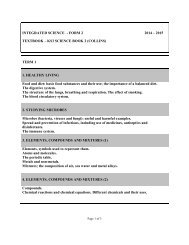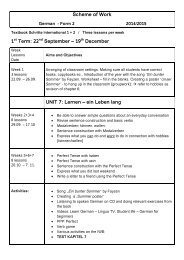FORM 3 - St Joseph School, Blata l-Bajda
FORM 3 - St Joseph School, Blata l-Bajda
FORM 3 - St Joseph School, Blata l-Bajda
Create successful ePaper yourself
Turn your PDF publications into a flip-book with our unique Google optimized e-Paper software.
Textbooks: Edexcel International GCSE Chemistry by Graham Hill & Robert Wensley<br />
Calculations for GCSE Chemistry by E. N. Ramsden<br />
1 ST TERM<br />
TOPIC DETAILS PRACTICALS<br />
1. STATES OF MATTER Physical characteristics of each state.<br />
<br />
<br />
Changes of state.<br />
The state in which a substance will exist at room temperature in terms<br />
of melting and boiling point.<br />
<br />
<br />
Interpretation of a heating/cooling curve.<br />
Diffusion and Brownian motion in terms of the kinetic theory of matter.<br />
1
2. PHYSICAL and<br />
CHEMICAL CHANGES<br />
The differences between physical and chemical changes as shown through<br />
different experiments.<br />
3. ELEMENTS,<br />
<br />
Definition of an element.<br />
COMPOUNDS and<br />
<br />
The use of symbols of elements as shown in a periodic table.<br />
<br />
Filtration and Crystallization<br />
MIXTURES<br />
<br />
Metals and non-metals.<br />
<br />
Chromatography<br />
<br />
Formation of compounds from elements.<br />
<br />
Simple Distillation<br />
<br />
Differences between compounds and mixtures.<br />
<br />
Separation techniques.<br />
4. ATOMIC THEORY Definition of an atom and a molecule.<br />
<br />
<br />
Naming compounds.<br />
Writing formulae of compounds using valency.<br />
5. ATOMIC STRUCTURE Proton, electron and neutron: relative charges and masses.<br />
<br />
<br />
<br />
Mass number and atomic number.<br />
Electron configuration.<br />
Atomic diagrams.<br />
2
Isotopes and relative molecular mass.<br />
<strong>St</strong>ability of the noble gas configuration and formation of ions.<br />
2 ND TERM<br />
6. CHEMICAL BONDING Electrovalent/ionic bonding.<br />
<br />
<br />
<br />
Covalent bonding.<br />
Metallic bonding.<br />
Covalent structures.<br />
HALF YEARLY EXAMS<br />
7. CHEMICAL<br />
EQUATIONS<br />
Writing balanced chemical equations starting from a word equation and<br />
including state symbols.<br />
8. AIR and<br />
<br />
%composition of gases in air.<br />
COMBUSTION<br />
<br />
Experiments to determine the % of oxygen in air.<br />
<br />
Candle experiment to<br />
<br />
Fractional distillation of air.<br />
determine % of oxygen in air<br />
3
Uses of the various gases found in air.<br />
<br />
Combustion of fuels and tests for water and carbon dioxide.<br />
<br />
Air pollution<br />
<br />
.Rusting experiment.<br />
<br />
Rusting<br />
3 rd TERM<br />
9. OXYGEN Laboratory preparation of oxygen from hydrogen peroxide.<br />
<br />
Preparation and tests of<br />
<br />
<br />
<br />
<br />
<br />
<br />
<br />
<br />
Test for oxygen.<br />
Industrial preparation of oxygen.<br />
Uses of oxygen.<br />
Physical properties of oxygen.<br />
Reaction of oxygen with metals and non-metals.<br />
Classification of oxides.<br />
Oxidation and reduction in terms of addition and removal of oxygen.<br />
Ozone and comparison to oxygen as its allotrope.<br />
oxygen.<br />
4
10. HYDROGEN Laboratory preparation of hydrogen from the action of a dilute acid on<br />
a metal.<br />
<br />
<br />
<br />
<br />
<br />
<br />
Test for hydrogen.<br />
Physical properties of hydrogen.<br />
Uses of hydrogen.<br />
Isotopes of hydrogen.<br />
Reaction of hydrogen with metals and non-metals.<br />
Hydrogen as a reducing agent.<br />
11. CALCULATIONS<br />
<br />
<br />
<br />
<br />
RAM, RMM.<br />
% composition of an element in a compound.<br />
% water of crystallization.<br />
Empirical and Molecular formulae.<br />
5

















